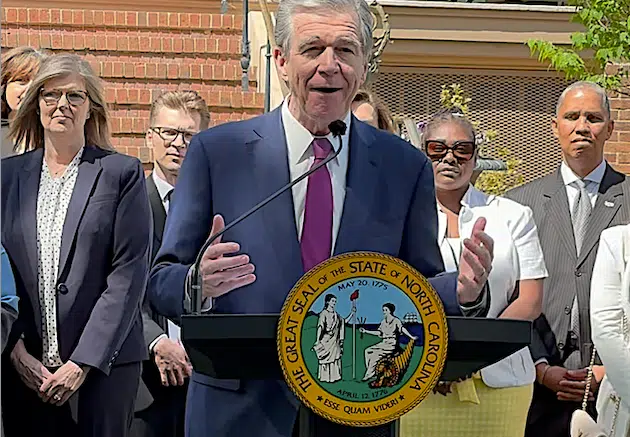By Anne Blythe
There’s an old saying that age is just a number.
But when you look at the state demographer’s projected growth of the 65-and-older population in North Carolina over the next decade, that’s more than just a number. It’s an eye-opening statistic.
From 2021 to 2041, the state’s older population is expected to grow from 1.8 million people to 2.7 million. If you focus on the 85-and-older population, a 114 percent increase is projected — going from 198,000 people three years ago to 423,000 in 17 years.
By 2031, state demographers predict, there will be more people in North Carolina over the age of 64 than younger than 18.
That expected population shift has generated significant strategizing and planning over the past year as advocates for older North Carolinians put the final touches on “All Ages, All Stages NC: A Roadmap to Aging and Living Well.”
The plan, which is expected to be finalized in the weeks ahead, was spurred by an executive order issued by Gov. Roy Cooper in May 2023 that called for a “whole-of-government approach” to make the state hospitable to an increasingly aging population.
There are findings and at least 150 recommendations that touch on an array of topics. That includes:
- The confusion and awareness about available resources.
- Transportation needs.
- Barriers to aging in place.
- The cost and availability of caregivers, long-term care facilities and other support services.
- Social connectivity.
- Worries about outliving financial resources and planning.
“I’m not even calling it a plan, it’s a strategic roadmap,” said Steve Hahn, a spokesperson for AARP North Carolina. “We have a great opportunity to really use this roadmap to really guide smart decision-making to make these investments that help all ages. There’s a lot of consensus-based ideas that can really help move us along.”
‘A living document’
Mary Bethel, chair of the NC Coalition On Aging board of directors, played a key role in developing the roadmap. The state Department of Health and Human Services Division of Aging and other creators of the plan conducted listening tours, gathered data and research, and collected strategy and policy ideas for the graying of the state’s population as the tail end of the Baby Boomer generation moves closer to 65.
Over the coming weeks, as the draft report is refined and a public awareness campaign is launched, finishing touches will be put on metrics for measuring achievements and the development of a data dashboard to track them.
The goal is to present a report to the governor by May 2 that will be updated every two years with progress reports and new goals.
“The idea is for this to be a living document that serves as a foundation for getting us started,” said Bethel, who has a 40-year history working on aging issues in this state.
One key goal in the plan is to ensure that North Carolinians have access to community health resources that can help optimize their life expectancy and health quality.
That includes ensuring that acute care and long-term supports and services are available in all communities so older residents “can access and successfully transition between appropriate types of care in an array of settings, based on their changing needs and preferences.”
That might mean more telehealth options, community-based care and other essential services that make care and communication with health care professionals more accessible to a wider swath of residents.
Long-term care options will play a key role too. The number of people diagnosed with Alzheimer’s disease and dementia is expected to rise to 400,000 in only two years, according to Cooper’s executive order.
“During a person’s lifetime, seven out of 10 people will need long-term care,” Bethel told NC Health News.
At top of mind
Other key issues the roadmap developers heard about on their listening tour reverberate across generational lines — such as the cost of housing, workforce shortages that make finding and keeping caregivers all the more difficult and feeling the financial squeeze as the cost of living rises.
Some people talked about limited transportation services and having to spend four to five hours in a van just to go to a medical appointment.
Others spoke of the disparate amenities available at certain senior centers based on the income levels of the communities where they were located. They spoke of feeling discriminated against based on race, ethnicity and sexual orientation.
People interested in staying in their homes as they aged lamented the rising prices for maintaining their homes and the cost of outfitting them for mobility problems and home medical equipment needs.
Among the recommendations for staving off some of these concerns are:
- Providing free or low-cost home safety modifications, repairs or home improvements.
- Expanding transportation services and the availability of senior center vans.
- Establishing lending libraries for used durable medical equipment.
- Advocating for Social Security and Medicare payroll taxes paid by undocumented workers to be returned to the state to fund programs for those workers.
- Expanding recruitment strategies to increase the statewide number of doctors and other health providers of color for improved patient-provider racial accordance, communication and outcomes.
- Increasing opportunities for older adults to share their wisdom and knowledge with younger generations as well as providing more opportunities for them to be mentored on technology advances and other topics.
- Funding senior centers equitably statewide based on the estimated 65-and-older population instead of property tax revenues.
- Including older adults more often in decision-making around policies that have an impact on them.
Some of the recommendations eventually could land on the desks of state lawmakers. Others could be directed to municipal or county governments.
May 7 is Aging Advocacy Day at the General Assembly. Bethel and Hahn said there are no plans to ask lawmakers for anything this year. Instead, they are interested in sharing data, educating them on the roadmap and making them aware of the steps being taken.
Many of the ideas could help younger generations, too, whether they are caring for elderly parents and family members or hoping to live in communities that welcome and care for its population at every stage of life.
“It’s just recognizing that what we do for the old helps all ages,” Hahn said.














